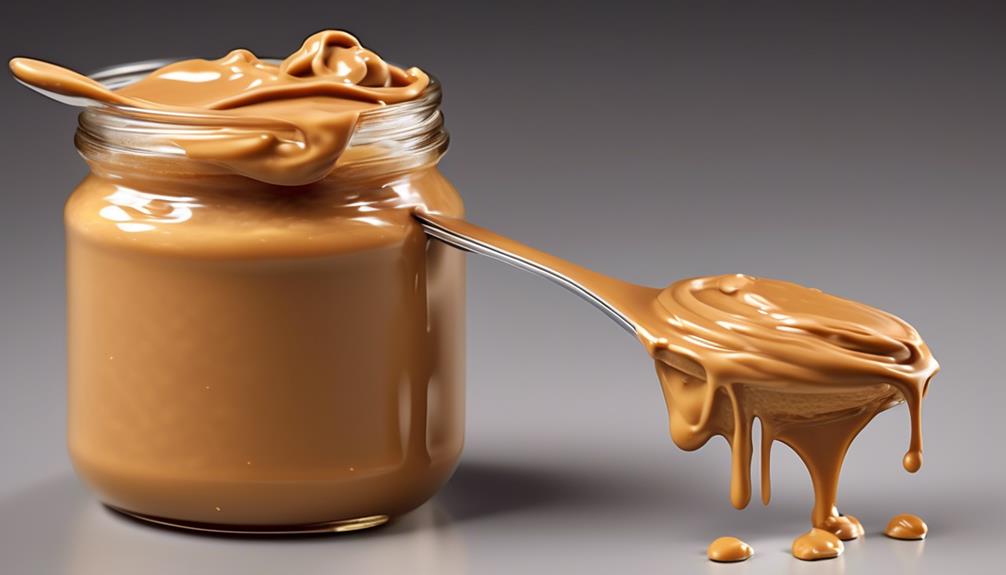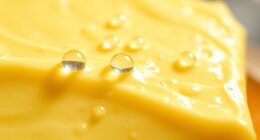When checking peanut butter labels, look for products that list only peanuts and maybe a bit of salt. Avoid those with sugar high up on the ingredients list, as they contain added sweeteners that can drive up sugar content. Natural peanut butter usually has 1-2 grams of sugar per serving, while commercial varieties may have 3-6 grams or more. Understanding these details can lead you to healthier choices—there’s more to explore on this topic!
Key Takeaways
- Check the ingredient list for “natural” or “unsweetened” to find peanut butter with minimal sugar.
- Look for products with only peanuts and a pinch of salt for the healthiest option.
- If sugar is listed before peanuts, the product likely contains a high amount of added sugars.
- Compare sugar content; natural peanut butter usually has 1-2 grams per serving versus 3-6 grams or more in commercial varieties.
- Reading labels helps you avoid unnecessary calories and supports healthier dietary choices.

While you might enjoy the creamy texture and nutty flavor of peanut butter, it’s important to check the label for added sugar. Many popular brands pack their products with sweeteners, which can obscure the health benefits you’re after. When you’re standing in the grocery aisle, a quick look at the ingredients can save you from choosing a jar that adds unnecessary calories to your diet. So, how can you navigate this maze of choices?
Start by looking for “natural peanut butter.” This type often contains just peanuts and maybe a pinch of salt. You’ll find that natural peanut butter typically has a lower sugar content, making it a smarter choice if you’re watching your sugar intake. In contrast, those commercial varieties frequently feature sugar as one of the first few ingredients. If you see sugar listed before peanuts, it’s a red flag that you’re getting more sweetener than you bargained for.
Look for natural peanut butter with just peanuts and a pinch of salt for a healthier choice.
Now, let’s talk about sugar content comparison. When you compare two jars side by side, you might be surprised by the differences. A typical jar of natural peanut butter might have around 1-2 grams of sugar per serving, while a sugary alternative can have 3-6 grams or even more. That’s a significant difference! If you’re spreading it on toast or using it in a smoothie, those extra grams can add up quickly and skew your diet.
It’s not just about the sugar itself but also about how it affects your overall health. Consuming too much added sugar can lead to weight gain, increased risk of chronic diseases, and other health issues. So, when you’re reading labels, keep the sugar content in mind. You might think you’re making a healthy choice, but if that peanut butter is loaded with sugar, it defeats the purpose. Grocery savings strategies can also help you make budget-friendly choices while selecting healthier options.
Incorporating natural peanut butter into your meals is an easy way to enjoy its benefits without the guilt. Whether it’s a dollop on your oatmeal or a spread on whole-grain bread, you’ll savor the rich flavor without worrying about extra sugar. Just remember to check the labels, and you’ll find that making healthier choices is simpler than you think. So next time you reach for that jar, make sure you know what you’re actually getting!
Frequently Asked Questions
What Are the Health Effects of Added Sugars in Peanut Butter?
Added sugars in peanut butter can lead to blood sugar spikes, making it harder for your body to maintain stable energy levels. This can leave you feeling sluggish and craving more sugar. Additionally, consuming too much added sugar can negatively impact your dental health, increasing the risk of cavities and gum disease. By choosing natural options, you’ll avoid these pitfalls and enjoy the health benefits of peanut butter without the drawbacks.
Are There Any Natural Peanut Butter Brands Without Added Sugar?
Yes, there are plenty of natural peanut butter brands without added sugar. While some options are loaded with sweeteners, brands like Smucker’s Natural, Justin’s, and Teddie offer sugar-free choices that let the peanut flavor shine. You’ll love how these products keep your snacking pure and simple. By choosing sugar-free options, you’re not just avoiding added sugars; you’re embracing a healthier lifestyle that’s both delicious and nutritious. Go ahead, indulge guilt-free!
How Does Added Sugar Affect Peanut Butter’s Taste and Texture?
Added sugar enhances the sweetness of peanut butter, making it taste richer and more appealing to those who prefer a sweeter spread. However, it can also modify the texture, creating a creamier consistency that some might enjoy. If you like your peanut butter with a hint of sweetness, the added sugar might be just right for you. On the other hand, if you prefer a more natural flavor, look for brands without it.
Can I Make My Own Peanut Butter Without Added Sugar?
Absolutely, you can make your own peanut butter without added sugar! Imagine blending roasted peanuts in a food processor until smooth, creating a creamy delight. You can find homemade recipes that incorporate sugar alternatives like honey or maple syrup for a touch of sweetness, but it’s optional. Just add a pinch of salt to enhance the flavor. With a little experimentation, you’ll craft a delicious spread tailored to your taste!
What Are Alternative Spreads to Peanut Butter With No Added Sugar?
You can try several alternative spreads that contain no added sugar. Look for nut butter varieties like almond, cashew, or hazelnut, which often have a natural sweetness. You might also consider sunflower seed butter or coconut butter for a different flavor profile. If you want a touch of sweetness, use natural sweeteners like honey or maple syrup in moderation. These options can elevate your snacks without the extra sugar found in many commercial spreads.
Conclusion
In the vast forest of grocery aisles, where jars of peanut butter stand like ancient trees, knowing how to read labels is your compass. By avoiding added sugars, you’re choosing the path that leads to health and vigor, much like a wise traveler who seeks the purest spring water. So, take a moment to inspect the ingredients; your journey toward wholesome choices begins with understanding what you’re truly embracing. Let clarity guide you through the thicket of options.









